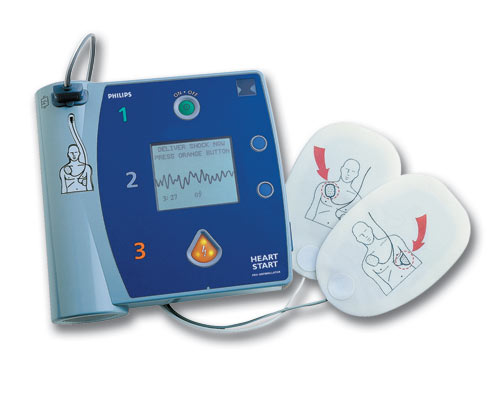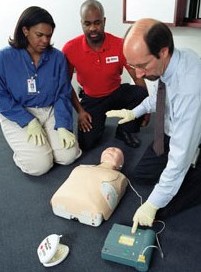Sequence of actions when using an automated external defibrillator 
The following sequence applies to the use of an automatic AED in a victim who is found to be unconscious and not breathing normally.
1. Follow the adult BLS sequence as described in the basic life support chapter. Do not delay starting CPR unless the AED is available immediately.
2. As soon as the AED arrives:
If more than one rescuer is present, continue CPR while the AED is switched on. If you are alone, stop CPR and switch on the AED.
Follow the voice / visual prompts.
Attach the electrode pads to the patient’s bare chest.
Ensure that nobody touches the victim while the AED is analysing the rhythm.
3A. If a shock is indicated:
Ensure that nobody touches the victim.
Push the shock button as directed (fully-automatic AEDs will deliver the shock automatically).
Continue as directed by the voice / visual prompts.
Minimise, as far as possible, interruptions in chest compression.
3B. If no shock is indicated:
Resume CPR immediately using a ratio of 30 compressions to 2 rescue breaths.
Continue as directed by the voice / visual prompts.
 4. Continue to follow the AED prompts until:
4. Continue to follow the AED prompts until:
qualified help arrives and takes over OR the victim starts to show signs of regaining consciousness, such as coughing, opening his eyes, speaking, or moving purposefully AND starts to breathe normally OR
you become exhausted.
Placement of AED pads
 Place one AED pad to the right of the sternum (breast bone), below the clavicle (collarbone). Place the other pad in the left mid-axillary line, approximately over the position of the V6 ECG electrode. It is important that this pad is placed sufficiently laterally and that it is clear of any breast tissue. Although most AED pads are labelled left and right, or carry a picture of their correct placement, it does not matter if their positions are reversed. It is important to teach that if this happens ‘in error’, the pads should not be removed and replaced because this wastes time and they may not adhere adequately when re-attached.
Place one AED pad to the right of the sternum (breast bone), below the clavicle (collarbone). Place the other pad in the left mid-axillary line, approximately over the position of the V6 ECG electrode. It is important that this pad is placed sufficiently laterally and that it is clear of any breast tissue. Although most AED pads are labelled left and right, or carry a picture of their correct placement, it does not matter if their positions are reversed. It is important to teach that if this happens ‘in error’, the pads should not be removed and replaced because this wastes time and they may not adhere adequately when re-attached.
The victim’s chest must be sufficiently exposed to enable correct pad placement. Chest hair will prevent the pads adhering to the skin and will interfere with electrical contact. Shave the chest only if the hair is excessive, and even then spend as little time as possible on this. Do not delay defibrillation if a razor is not immediately available.